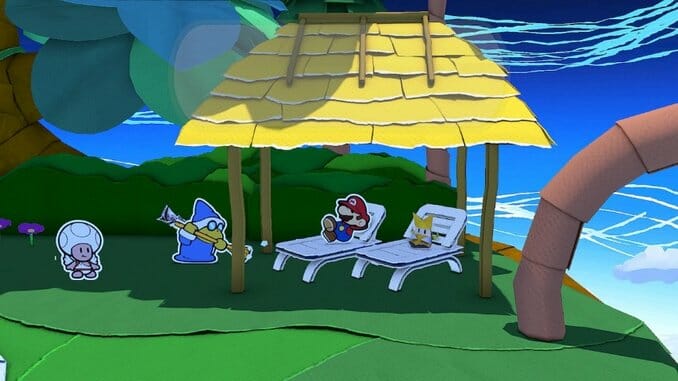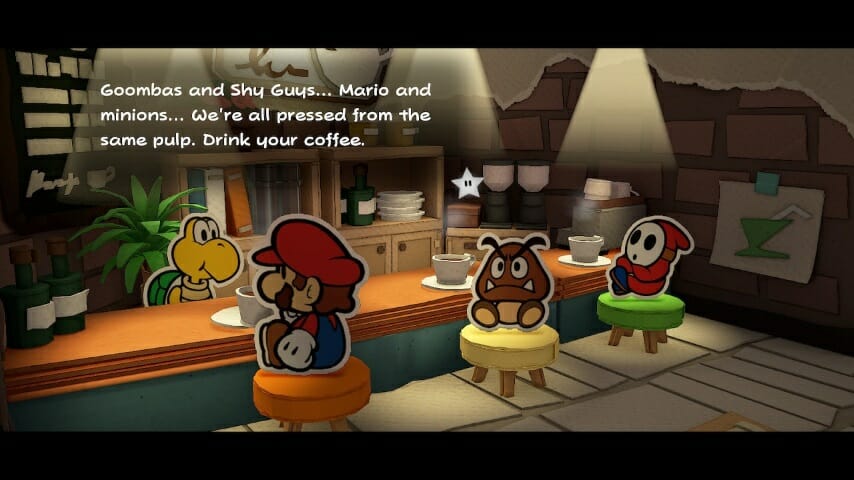
Paper Mario: The Origami King isn’t the Paper Mario game anybody asked for. It doesn’t have any traditional RPG systems and there aren’t a large cast of side characters to join Mario’s party for the journey. Instead, it aims to create a world filled with playful variation while still maintaining a charming cohesion. Many times it succeeds, but from this success a more somber theme emerges.
When Mario arrives at Princess Peach’s castle for a festival he is horrified. Peach has been made into a malformed origami version of herself. A new foe reveals himself as Olly, the origami king (yup, that’s the name of the game), and he has a dream of making the entire world into origami. In classic Mario fashion, the castle is lifted from the ground and into the air with a number of barriers that drive our hero across the Mushroom Kingdom for removal. This time, five giant streamers stretch across the world and wrap the castle in a colorful imprisonment. These streamers take Mario on a journey filled with fun and goofy people and places.
Thanks to the series’ beginnings in RPGs, Paper Mario has always held strength in the augmentation of its world details. What used to be side-scrolling and speechless, transformed into characters with communities and motivations. Origami King continues this trend as every area is littered with characters ready to tell you a funny, self-aware joke. It’s cute, and it doesn’t take itself too seriously. I wish more games were written like this one.
These characters are amplified by their integration into the world and its puzzles. Due to the paper-based nature of their existence, characters are stuffed inside of holes, folded up into trees, or trapped inside boxes. No matter where Mario hammers and jumps there is bound to be someone that will pop up. Somehow it’s never overwhelming either.
Rather than an RPG, Origami King feels like a mature Pajama Sam or Putt-Putt. I mention these specific adventure games because there are a lot of objects to interact with in the world just for the sake of goofy interaction. Cheep-cheeps fly out of the water increasingly each time Mario hits a specific tree, and several toads pop out of a doorway when Mario unseals it. There is more to the world than just minute detail and moving forward—the game deliberately carves out moments for these characters to shine.
I continue to think about one moment in a hidden coffee shop.
About halfway through my playtime I discovered a coffee shop hidden in the walls of a water temple. I opened up the door to find a koopa with two of Bowser’s minions relaxing and drinking coffee. “What will you have?”, the koopa asked me. I bought the Un Café and listened to the shy guy and goomba jest about which of the minions is cooler. It was a small moment, but it was mundane. It was nonsense. I loved it.

Origami King is what I imagine what Mario Party would be like if it took all the minigames and found a cohesive way to contextualize them in a game world. Yeah, I guess one of those games is a turn-based battle system, but it really isn’t the star of the show. It doesn’t compare to sailing the seas and going diving in a submarine for treasure or shooting down planes out of the sky with a bob-omb cannon. The world of Origami King is so fun just to explore and play in. There is always something unexpected in the world packed full of paper. And because it’s so fun, I didn’t care about the foregone RPG elements at all.
Origami King is ambitiously entertaining, if nothing else, but this is also where I find many of the game’s flaws. Because the world is so fun to play in, the battle system becomes a hindrance in comparison. Essentially it’s a board game where you swivel and slide pieces to achieve your goals in battle. An enemy may need to be placed in one position, or, in ChuChu Rocket! fashion, arrow tiles need to be placed in sequence for Mario to run to an attack tile. It isn’t a bad system by any means. But because it is designed as a repeated disruption from the rich exploration of the world it quickly becomes a nuisance.
Luckily there are many times where the system can be circumnavigated. There aren’t any experience points or levels in the game, and most enemies can be avoided aside from a few here and there. Really from the beginning it only feels like a system made to make the game longer, especially when some of the biggest moments in the game don’t even happen within the battle system. Why would I want to tediously place enemies into a row when I could be solving the mysterious puzzle of the toad towers or finding my way through a ninja themed escape room?
The shining moments of this game really come from everything else that makes up Mario’s journey. Entire chapters of the game change traversal forms and introduce unique game mechanics that never return again. One fifth of my playtime I spent sailing and exploring islands across the paper sea. Some of the boss battles never occur in the battle system but have specific encounters designed for their contexts. On a ghost ship I had to dodge and hammer blooper tentacles that were surrounding and shooting at Mario. It’s hard to encapsulate it all here because there are just so many different things that happen in this game. By focusing on the battle system, so many moments in this game are overshadowed.
It’s also because of these many playful moments that another part of me feels critical towards Origami King. After reaching a point of realization that the battle system wasn’t the primary focus of the game, I began to recognize its other inspirations.
Sailing on the sea and exploring islands reminds me of The Legend of Zelda: Wind Waker. Dueling enemies on stage in performed gunfights remind me of 1 2 Switch. Shooting down wave based enemies in the sky reminds me of Galaga. Even though I was having a lot of fun with the world of Origami King I also felt disappointed that many of these smaller vignettes were just condensed versions of popular game designs. I can’t help but feel that with such a creative, humorous team making this game they could have designed anything for the player to do, but for some reason the most compelling choice was “give Mario a gun,”
This reveals the limited ambition of Origami King, and Nintendo as a corporate game company at that. Historically there is a standard of corporate design meant to adhere to a limited audience and alienate the rest. Videogames are saturated with decades of colonial, masculine, military violence and foster a dominant culture of design through its standards. Despite the charm and fun that is in Origami King, it can’t imagine game design outside of the realm that corporate game development has engendered.
Unfortunately, this means there are implicit harmful politics within the game because it upholds these values.
A power that Olivia can use throughout the adventure is the transformation into velumentals via magic circle. These vellumentals take a lot of inspiration from Super Sentai as transformation sequences and giant monster battles are prominently featured. However, in order to obtain these powers they must be stolen.
When I say stolen I mean Mario enters shrines built for local animal gods, who are minding their business, and kills them to take their powers. While there isn’t much said about these battles, I found myself really uncomfortable with killing each vellumental. Here I was breaking into a places of home and worship only to kill and steal.
The characters never say much about these actions, and because it’s Paper Mario there isn’t much expressed about the plumber’s raids aside from a cute mustache twiddle. However, this lack of recognition doesn’t take away the theme of violence in these moments. When each vellumental is defeated, they fall down, crying in pain, before being forced into a book for Mario to take on his journey.
There is also possibly the worst treatment of Princess Peach as a character that I can remember in recent history. She’s turned into a servant for the villain of the game and eventually just becomes the centerpiece of his wall later on. If she wasn’t objectified enough as the object of marriage then maybe just make her a piece of architecture I guess?
I think about these politics each time I am struck by the landscapes of Mario’s journey. I look over the beautiful landscapes formed by the layering of colored parchment. The rush of wind in the sky is made up of torn streams of paper. The dunes of sand are striped with lines of purple construction paper. It’s the extreme detail to the perforations, the rigid textures, and shadows that really make everything look like a diorama. While Origami King has laid a lot of my retro Paper Mario nostalgia to rest, the high fidelity of the game only reminds me what the cultural standard of videogames are today.
Many of these implicit politics shine through Origami King and despite the joys I had playing, I only found reason to be excited for smaller studios making games inspired by the series. Sure, it has a lot of funny jokes. A lot of the little puzzles and vignettes are also fun as well. However, it’s hard to look past the masculinist colonialist ideals it holds onto and consider coming back again. I’m not sure I’ll be able to forget the fun and laughter of Origami King, but I also won’t forget its problems.
Paper Mario: The Origami King was developed by Intelligent Systems and published by Nintendo. It’s available for the Switch.
Waverly is a trans game artist and freelance writer. She has written at Uppercut, Into The Spine, and Fanbyte. You can find her on Twitter @hotelbones.